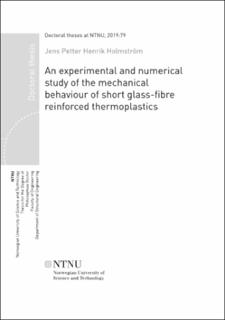| dc.description.abstract | This thesis presents an experimental and numerical investigation of injection-moulded short glass-fibre reinforced thermoplastics subjected to monotonic tensile-dominated quasistatic loadings. Two classes of materials are investigated; polypropylene and polyamide-6 reinforced with 0 wt.%, 15 wt.% and 30 wt.% fibres, delivered as injection-moulded plates. X-ray computed tomography is applied for quantitative characterization of the fibre orientation distributions (FODs) and the variations of fibre orientations and fibre volume content through the thickness of the materials. For the polypropylene materials, the experimental programme for mechanical tests includes quasi-static uniaxial tensile tests in the 0°-, 45°- and 90°-direction relative to the mould flow direction (MFD), platewith-central-hole tests in the 0°-direction and three-point bending tests in the 0°- and 90°-direction. The reported tests for the polyamide materials include quasi-static uniaxial tensile tests for specimens oriented 0°, 15°, 30°, 45°, 60°, 75° and 90° relative to the MFD, and plate-with-central-hole and plane strain tests in the 0°-, 45°- and 90°-direction. Specifically designed test specimens gripped with pins are applied in the experiments of the polyamide materials. In all the mechanical tests, the deformations at the specimen surface are measured by application of digital image correlation on high-resolution images.
Two material models, an anisotropic elastic damage model and a mesoscopic model for fibre-reinforced materials, are first examined in numerical studies and then applied in simulations of the experiments.
• The anisotropic elastic damage model combines orthotropic elasticity with a linear softening law and assignment of a damage threshold value from a statistical distribution. Damage threshold values are assigned to a finite element model by a procedure which enables for user-control of the physical length scale of the damage threshold distribution. A regularization procedure is applied to reduce the mesh sensitivity of the simulations. The elastic part of the model is calibrated from the experiments, while the damage part is calibrated from simulations of a tensile test in the 0°-direction. A calibration procedure for orthotropic elasticity is presented.
• The mesoscopic model is a composite material model which combines a plasticity model (rate-independent J2-flow theory with isotropic hardening) with a number of linear elastic, one-dimensional fibre families. The fundamental assumption of the model is that the material phases are subjected to the same deformation (Voigt assumption), which gives the composite stress as a volume-weighted sum of the contribution from each phase, where the phases are independent of each other. The parameters of the plasticity model are obtained from tensile tests of the unreinforced polymer matrix, and the fibre phase is defined by a discretized fibre orientation distribution and the fibre volume fraction. No mechanical tests on the composite material are required to calibrate the model.
The X-ray computed tomography investigations reveal a three-layered shell-core-shell structure for the fibre-reinforced materials, where the predominant fibre orientation is along the MFD in the shell layers and perpendicular to the MFD in the core layer. The out-of-plane fibre orientation component is generally small. The fibre volume content is higher in the core layer than in the shell layers and the core layer is most pronounced for the materials with the highest fibre content.
The unreinforced materials are ductile and display significant strain hardening. Adding fibres to the unreinforced materials increases the stiffness and strength and reduces ductility, and the effect increases with the fibre content. For the fibre-reinforced polypropylene materials, brittle fracture occurs shortly after maximum force, while the fibre-reinforced polyamide materials display higher ductility. Strongly inhomogeneous strain fields evolve during deformation of the fibre-reinforced materials, caused by the formation of microcracks at the specimen surface. The fibre-reinforced materials show moderate to high degree of anisotropy, where the degree of anisotropy increases with the fibre content. Young’s modulus, in-plane and out-of-plane Poisson’s ratio, stress at maximum force, failure strain and characteristics of the strain fields vary smoothly with the in-plane specimen angle. It is demonstrated that orthotropic elasticity is an excellent approximation for all four injection-moulded glass-fibre-reinforced thermoplastics investigated in this work.
The anisotropic elastic damage model shows high capability of predicting the anisotropic behaviour of short-fibre-reinforced thermoplastics. The stiffness, tangent modulus and maximum stress from simulations of the tensile tests are in perfect agreement with the experiments. Fracture occurs shortly after maximum force is reached in the simulations, which implies that the fracture strain is underestimated for non-brittle material responses. Simulations of plate-with-central-hole tests, plane strain tests and three-point-bending tests demonstrate, again, that the stiffness and tangent modulus are in perfect agreement with the experiments. The maximum force and prediction of fracture in these simulations are generally in good agreement with the experiments, but the maximum force is slightly overestimated for some configurations. The strain fields from the simulations are more or less identical to the strain fields from the experiments.
Since no damage or failure criterion is formulated for the fibre phase in the mesoscale model for fibre-reinforced materials, the presented evaluation focuses on the elastic properties. The model is generally able to describe the anisotropic elastic behaviour observed in tensile tests, plate-with-centric-hole tests, plane strain tests and three-point-bending tests with high accuracy. The global results from tensile test simulations with different properties through the thickness are similar to the results obtained without the through-thickness discretization. | en_US |
